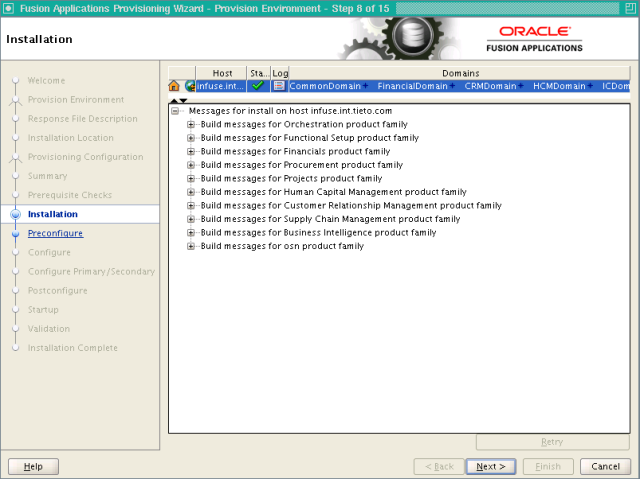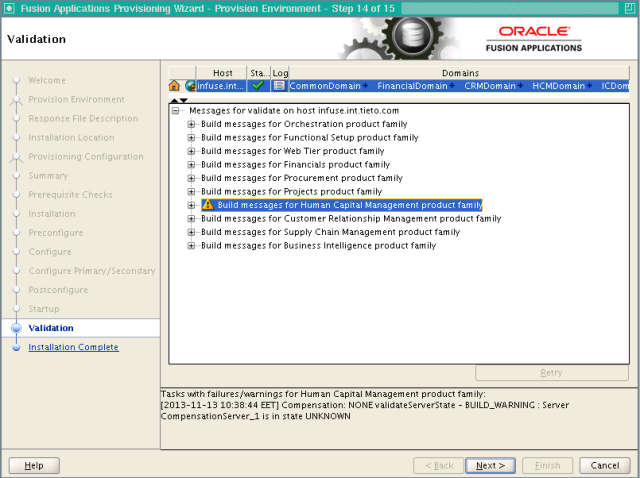It was a long road we made to come to this point. It is true that Fusion Applications bare metal provisioning takes some time and even if you don’t face any issues in the meanwhile it is around a week time that is required to get everything up and running. An installation of Oracle Fusion Applications is logically broken up into groups of features known as product offerings, which represent the highest-level collection of functionality that you can license and implement. A provisioning configuration is a collection of one or more product offerings. Oracle Fusion Applications Provisioning is a full-featured process that provides all the tools you need to set up a repository of installers and installation-related processes, present product configurations that you can install in your environment, provide a means to collect configuration details about those offerings, and run the installation phases necessary to perform configuration and deployment tasks.
Depending on the amount of offerings you’ve selected during Response file creation you might need around 150 GB of RAM on Fusion Apps host in order to accommodate all the products. If you are, for instance, going to provision just one offering as HCM, for example, according to Installation documents, you will have to have around 24 GB of RAM. In terms of storage, it is minimum of 300 GB that is required (even for one offering).
Since we’ve already installed Provisioning Framework during Response file creation, we can directly use it for Provisioning task as well. Launch the Provisioning wizard and choose the Response file we’ve created in the previous blog post:
cd /fusion_media/installers/faprov/Disk1 export JAVA_HOME=/fusion_media/jdk6 export DISPLAY=:01 ./runInstaller
 Next provide some information like Weblogic nodemanager credentials and application installation directories:
Next provide some information like Weblogic nodemanager credentials and application installation directories:
The wizard performs the following actions:
Preverify phase:
Verifies the existence of the system administrators group (if it was declared as existing during the wizard interview) and the existence of the designated super user in the identity store.
Preconfigure phase:
Prepares the Oracle Identity Management components for configuring as follows:
– Uploads the LDIF files to the identity store. These files contain entries that represent the application administrator groups used to update the identity store.
– Creates the system administrator group (according to what is indicated in the interview).
– Makes the super user a member of the administrators group and all the application family directory groups.
– Seeds the bootstrap of AppID and gives it membership in the system administrator group.
Configure phase:
Configures the Oracle Identity Management components as follows:
– Creates the Oracle Fusion Applications domains using the default Oracle WebLogic Server template, with the bootstrap AppID as an administrator.
– Disables the default authenticator and enables the LDAP authenticator.
– Starts the Oracle WebLogic Server domain using the bootstrap AppID.
Postconfigure phase:
Following configuration, the system administrator groups are assigned the appropriate enterprise roles at the product family level. Therefore, the super user has:
– Administrator privileges for all Oracle WebLogic Server domains and all middleware
– Functional setup privileges for all Oracle Fusion Applications offerings
– Administration privileges to Oracle Fusion Applications offerings, excluding
transactional privileges
In order to provision an Applications environment we need to successfully undergo all the above phases.
Please make sure you are not facing any error on the prerequisite checks phase. Otherwise, you might need to consult the Release Notes document for specific Fusion Applications release and see if there is any known issue present for relevant error and advice given on how to fix it. Remember, that all components, that we’ve installed and configured so far, including Identity and Access Management, must be running and configured correctly at this point. If there are any issues with Identity Management environment, you will not be able to provision Fusion Applications.
Installation phase is something that will take quite a long time depending on your hardware and available resource amount. Follow the other stages once the installation has been completed.
Please review the summary of installation in order to get information regarding URL’s for various resources within your Fusion Applications newly installed environment. If everything went fine, you should be able to see your Fusion Applications login page (URL depending on the Applications base port you’ve chosen):
Congratulations! You have now performed a bare metal provisioning of Fusion Applications environment!











